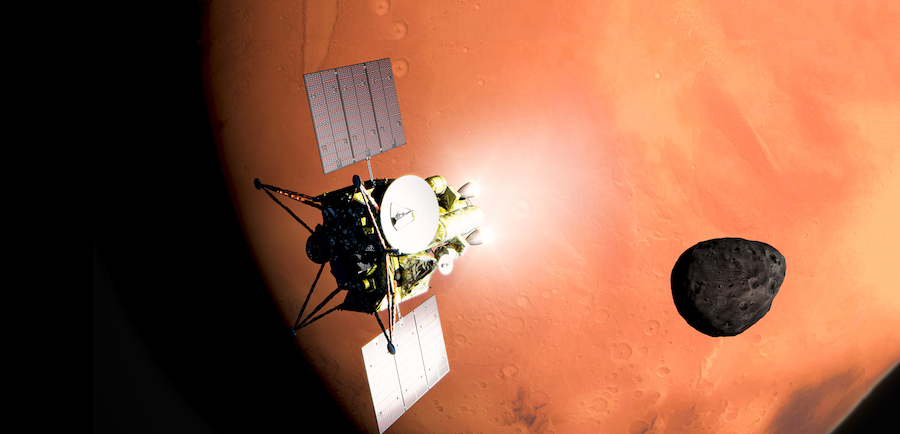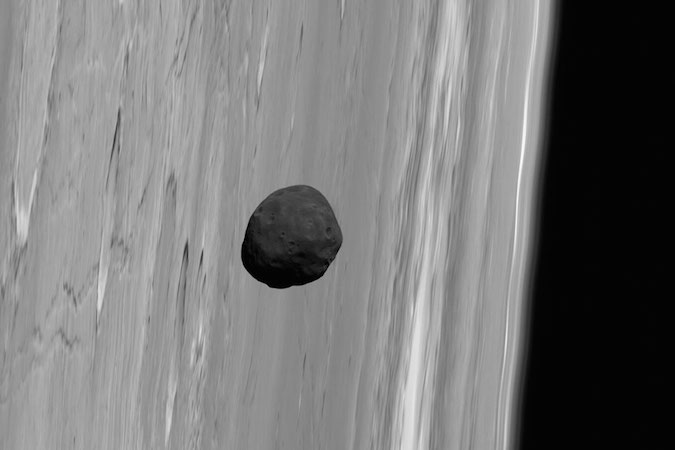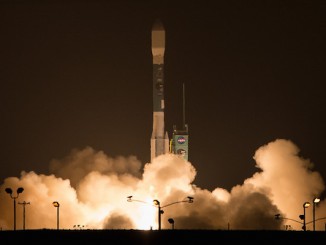
Japan’s space agency has approved a robotic mission to retrieve a sample from the Martian moon Phobos for return to Earth to begin full development for a planned launch in 2024, officials said Thursday.
The Martian Moon eXploration, or MMX, spacecraft will attempt to return the first specimens from Phobos for analysis in laboratories on Earth, where scientists hope to trace the origins of the Martian moons to determine whether they were asteroids captured by Mars, or if they formed out of rocky debris generated from an ancient impact on Mars.
The Japan Aerospace Exploration Agency and other Japanese government officials officially approved the MMX project to proceed into development Wednesday, according to a post on JAXA’s website.
JAXA began studying the feasibility of a sample return mission to Phobos in 2015, and Japanese officials received promises of contributions to the MMX mission from the United States and Europe.
The MMX mission’s transition from a “pre-project” phase to an official JAXA project Wednesday came after agency leaders considered the probe’s scientific goals, success criteria, implementation, financial plans, schedule, and risks and countermeasures, according to JAXA.
The MMX spacecraft is scheduled for launch in September 2024 aboard a Japanese H3 rocket. The robot explorer will arrive in orbit around Mars in August 2025 and land on Phobos, a moon with an average diameter of about 14 miles, or 22 kilometers.
The probe will land on Phobos and snare at least 10 grams, or about a third of an ounce, of material from the moon’s surface using a coring collection system before taking off again. MMX will also release a German-French rover to explore the terrain and chemical composition of Phobos for roughly three months.
MMX will perform several close flybys of Deimos, the smaller of Mars’s two moons, before departing the orbit of Mars in 2028 on a course back to Earth, where a sample return carrier will re-enter the atmosphere and land containing specimens gathered at Phobos.
The MMX spacecraft’s return to Earth in 2029 would complete the first round-trip voyage to Mars and back, JAXA said.

The MMX spacecraft will consist of three main elements: A propulsion module, a landing module with four legs and science instruments, and a sample carrier to return rocks from Phobos back to Earth.
The mission will carry a NASA-funded instrument — named MEGANE, meaning “eyeglasses” in Japanese — to measure the elemental composition of Phobos by detecting neutrons and gamma-rays emitted from the small moon.
French scientists committed to build an infrared camera and spectrometer named MacrOmega to fly on the MMX spacecraft. Like MEGANE, the French instrument will help scientists locate the best place to collect a sample.
In 2018, the German and French space agencies agreed with JAXA to provide a small rover for the MMX mission based on the MASCOT robot deployed on the surface of asteroid Ryugu by Japan’s Hayabusa 2 spacecraft.
The scientific objectives of the MMX mission are aimed at studying how water was transported between bodies in the early solar system, including to Earth. Scientists think the solar systems’s inner planets were too close to the hot sun during the solar system’s formation to have retained water on their surfaces.
Therefore, scientists theorize that water was delivered to planets like Earth by comets and asteroids. Mars is the outermost of the solar system’s rocky planets, and could have been a “gateway” for water arrival in the inner solar system, according to JAXA.
“Phobos and Deimos resemble asteroids and may have been captured by Mars’s gravity as they were scattered inwards from the asteroid belt,” JAXA wrote in a press release Thursday. “If so, the pair would be capsules for water transport through the Mars gateway to the terrestrial planets.
“Alternatively, the moons may have formed during a giant impact with Mars,” JAXA continued. “This would make the moons capsules of shards of the early Martian environment, revealing how water came and went on the Red Planet.
“A main mission goal for MMX is to decipher the origin of the moons by remote examination and returning a sample for compositional analysis,” JAXA said. “Both possible origins will provide clues as to how water is delivered to inner planets.”
MMX builds upon JAXA’s two previous asteroid sample return missions.
The Hayabusa spacecraft launched in 2003 and collected microscopic samples from asteroid Itokawa in 2005. The probe returned the material to Earth in 2010, overcoming multiple technical malfunctions that threatened to prematurely end the mission.
Hayabusa 2 launched in 2014 and collected samples from Ryugu — a carbon-rich asteroid — during two touch-and-go landings last year. The spacecraft has departed Ryugu and is on track to return the samples to Earth late this year.
Email the author.
Follow Stephen Clark on Twitter: @StephenClark1.



